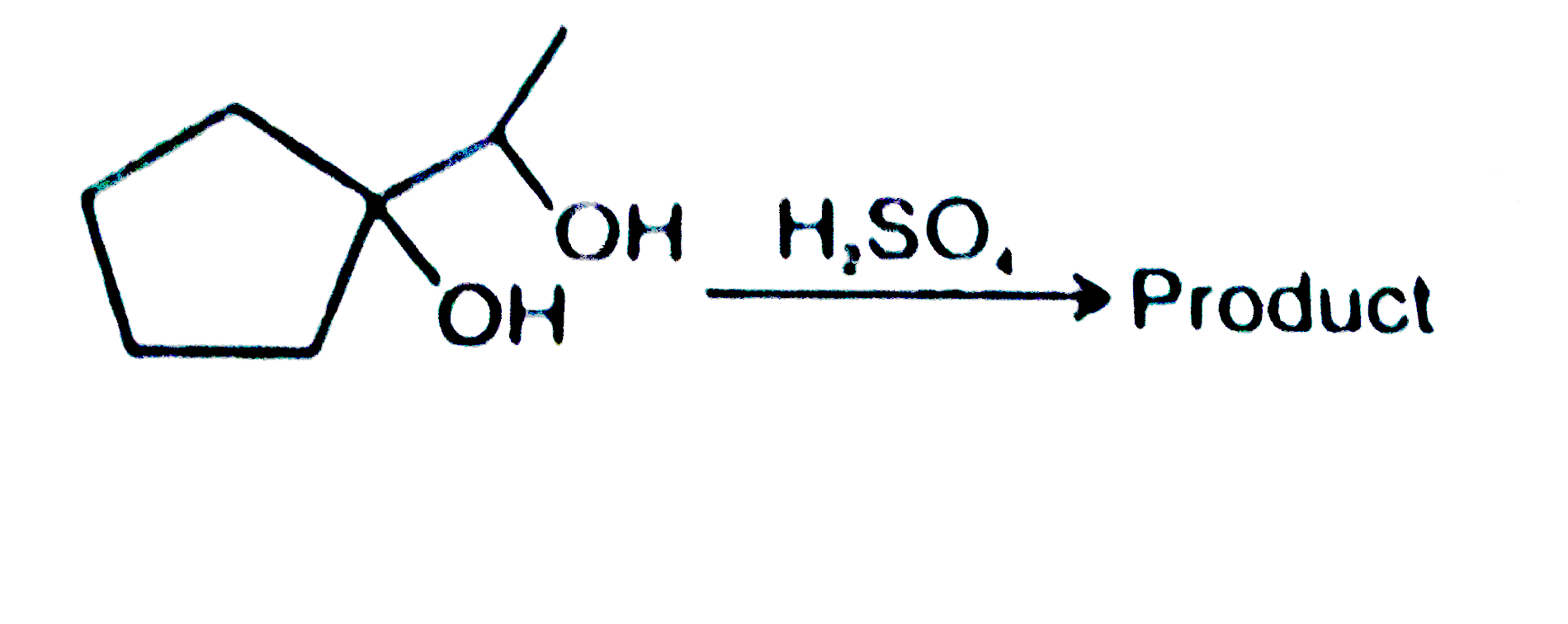1∘ alcohols preferably undergo dehydration via
E1
E2
SN1
SN2
The correct Answer is:B
Step-by-Step Solution:
1. Identify the Type of Alcohol:
- The question specifies "1° alcohol" (primary alcohol). An example of a primary alcohol is ethanol (CH3CH2OH).
2. Understand the Dehydration Process:
- Dehydration of alcohols involves the elimination of water (H2O) from the alcohol molecule, leading to the formation of alkenes.
3. Reaction with Acid:
- When a primary alcohol reacts with a strong acid like dilute sulfuric acid (H2SO4), the alcohol undergoes protonation. The hydroxyl group (OH) of the alcohol accepts a proton (H+) from the acid, forming an alkyl oxonium ion (CH3CH2OH2+).
4. Formation of Carbocation:
- The alkyl oxonium ion is unstable and will lose a water molecule (H2O), leading to the formation of a carbocation (CH3CH2+). This step is crucial as it indicates the formation of a reactive intermediate.
5. Elimination of Proton:
- In the presence of a base, a proton (H+) is removed from the adjacent carbon atom of the carbocation, resulting in the formation of a double bond. This step leads to the formation of an alkene (CH2=CH2).
6. Mechanism Type:
- The dehydration of primary alcohols typically follows the E2 mechanism rather than E1 because E1 mechanisms are more common with tertiary alcohols due to the stability of the carbocation formed. In the case of primary alcohols, the elimination occurs in a concerted manner (E2).
7. Conclusion:
- Therefore, the preferred mechanism for the dehydration of 1° alcohols is the E2 mechanism.
Final Answer:
1° alcohols preferably undergo dehydration via E2 mechanism.
---
- The question specifies "1° alcohol" (primary alcohol). An example of a primary alcohol is ethanol (CH3CH2OH).
- Dehydration of alcohols involves the elimination of water (H2O) from the alcohol molecule, leading to the formation of alkenes.
- When a primary alcohol reacts with a strong acid like dilute sulfuric acid (H2SO4), the alcohol undergoes protonation. The hydroxyl group (OH) of the alcohol accepts a proton (H+) from the acid, forming an alkyl oxonium ion (CH3CH2OH2+).
- The alkyl oxonium ion is unstable and will lose a water molecule (H2O), leading to the formation of a carbocation (CH3CH2+). This step is crucial as it indicates the formation of a reactive intermediate.
- In the presence of a base, a proton (H+) is removed from the adjacent carbon atom of the carbocation, resulting in the formation of a double bond. This step leads to the formation of an alkene (CH2=CH2).
- The dehydration of primary alcohols typically follows the E2 mechanism rather than E1 because E1 mechanisms are more common with tertiary alcohols due to the stability of the carbocation formed. In the case of primary alcohols, the elimination occurs in a concerted manner (E2).
- Therefore, the preferred mechanism for the dehydration of 1° alcohols is the E2 mechanism.
1° alcohols preferably undergo dehydration via E2 mechanism.
Similar Questions
Knowledge Check
A hydra moves via :
AnematocystsBcontraction of the nerve netCepitheliomuscular fibres in the epidermisDepitheliomuscular fibres in the mesogleaWhich of the following alcohols will undergo easiest dehydration?
A B
B C
C D
D
Which of the following alcohols undergo rearrangement during dehydration reaction ?
A B
B C
C D
D
Alcohols undergo acid catalysed elimination reactions to produce alkenes. Because water is lost in the elimination , this reaction is called dehydration reaction. Secondary and tertiary alcohols always give E1 reaction in dehydration. Primary alcohols whose β-carbon is branched also give E1 reaction. The reactivity of alcohol for elimination reaction is tertiary alcohol > secondary alcohol > Primary alcohol.
Which of the following dehydration product (major ) is incorrect ?
View SolutionAlcohols undergo acid catalysed elimination reactions to produce alkenes. Because water is lost in the elimination , this reaction is called dehydration reaction. Secondary and tertiary alcohols always give E1 reaction in dehydration. Primary alcohols whose β-carbon is branched also give E1 reaction. The reactivity of alcohol for elimination reaction is tertiary alcohol gt secondary school gt Primary alcohol.
Identify the product in the given reaction :

View SolutionFor the dehydration reaction.

View SolutionArrange reactivity of given alcohols in decreasing order for dehydration reaction with concentrated H2SO4

View SolutionPredict the product when alcohol
 undergoes dehydration with conc. H2SO4.
undergoes dehydration with conc. H2SO4.
View Solution

